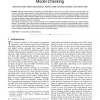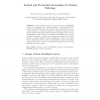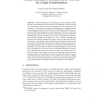88 search results - page 16 / 18 » Expressing Implicit Semantic Relations without Supervision |
TDSC
2010
13 years 14 days ago
2010
Although recent estimates are speaking of 200,000 different viruses, worms, and Trojan horses, the majority of them are variants of previously existing malware. As these variants m...
WOLLIC
2010
Springer
13 years 10 months ago
2010
Springer
Abstract. We present a modal language that includes explicit operators to count the number of elements that a model might include in the extension of a formula, and we discuss how ...
TSD
2007
Springer
13 years 12 months ago
2007
Springer
Sound ontologies need to incorporate source unidentifiable sounds in an adequate and consistent manner. Computational lexical resources like WordNet have either inserted these des...
KBSE
1999
IEEE
13 years 10 months ago
1999
IEEE
The language AML is used to specify the semantics of architecture description languages, ADLs. It is a very primitive language, having declarations for only three constructs: elem...
FM
2006
Springer
13 years 9 months ago
2006
Springer
Formal modeling is a crucial first step in the analysis of safety critical communication protocols such as IP Telephony. These protocols are notoriously resistant to formal modelin...



